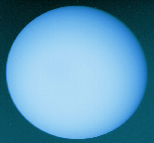Uranus

Introduction
- The surface of Uranus and its atmosphere are usually featureless and uniform,
so it is hard to calculate the rotation rate.
- However, in November of 1994 the Hubble Space Telescope, over a period of several hours, captured excellent photographs of the two bright spots in the planet's southern (up in the pictures) hemisphere.
- Let's use these spots, which serve as atmospheric features, to get an idea of how
fast the surface of the planet is spinning.
Internet Information
 Hubble tracks the rotation of Uranus
at 13:20, 16:34, and 21:23, UT 14 August, 1994
Hubble tracks the rotation of Uranus
at 13:20, 16:34, and 21:23, UT 14 August, 1994
 Textual information about the Hubble discovery
Textual information about the Hubble discovery
Strategy
- Place a transparent plastic over the screen, and line it up with the top of the screen.
- Trace the outline of the photo taken at 13:20 UT. Mark the center of spot B.
- Transfer the transparency to the middle image (the one taken at 16:34 UT). Line it up
with the top of the screen, then mark the new position of spot B.
-
To find out how long it takes Uranus to rotate once (to make one 360 -degree turn), put your transparency over the circle that has longitude lines drawn on it.
(It should be about the size of your Uranus image.)
- Figure out how many degrees spot B moved from 13:20 UT to 16:34 UT.
- Calculate the angular velocity and period of rotation of Uranus.
Questions
- How many degrees of longitude are between each line of longitude on the
diagram?
( Count the number of longitude lines. Divide 360 by that number.)
- How many degrees does spot B move?
((Count the number of lines that the spot moves through and multiply by the
number of degrees between each line (what you figured in #1 above.)
- How long does it take spot B to move 360 degrees?
(Between the first and second picture, the time elapsed was 16:34-13:20 =
3:14 hours or 194 minutes.)
You calculated the number of degrees the spot moved in 194 minutes, so
multiply 360 x 194, then divide the result by that number of degrees to get the rotation rate
(time it takes to rotate once).
-
How does the rotation rate of Uranus compare to Earth's? Jupiter's?
- What difference in rotation rate will you get if the tilt of the planet is taken into consideration?
- Since you measured Uranus's rotation rate by following an atmospheric cloud
formation for a couple of hours, is it possible that the cloud moved at a different
rate than the surface of the planet? Does that happen on Earth? Can you
think of a better way of calculating the rotation rate of Uranus? If you get any good
ideas, please let us know!
 Go back to the "Student Area"
Homepage
Go back to the "Student Area"
Homepage
 Go to Vocabulary Page
Go to Vocabulary Page
All text, images, and other resources in this
page are Copyright © 1995, The Regents of the University of California. All rights reserved.
For permission, email outreach@ssl.berkeley.edu.


![]() Hubble tracks the rotation of Uranus
at 13:20, 16:34, and 21:23, UT 14 August, 1994
Hubble tracks the rotation of Uranus
at 13:20, 16:34, and 21:23, UT 14 August, 1994
![]() Textual information about the Hubble discovery
Textual information about the Hubble discovery
 Go back to the "Student Area"
Homepage
Go back to the "Student Area"
Homepage